Renewable Energy Policies in the USA: A Comparative Study of Selected States
Abstract
1. Introduction
2. Materials and Methods
2.1. State Selection
2.2. Rubric Creation
Criteria and Indicators
- Renewable Energy Diversity: Assesses the availability of natural resources suitable for renewable energy production, factoring in weather patterns, biofuel resources, and water access for hydropower [29].
- Share of Renewable Energy in the Electricity Mix: Evaluates the percentage of electricity generated from renewables in 2020. States scoring above 70% received a score of 4, while those below 30% received a score of 1, indicating the importance of renewable energy transition and its potential for reducing GHG emissions [30].
- Government Involvement: Examines the state’s role in engaging stakeholders and developing energy strategies crucial for the energy transition [33].
- Policy Budget, Subsidies, and Loans: Considers funding for renewable energy policies and financial resources available to the public and businesses, influencing future renewable energy roles [34].
- Breadth of Policy and Integration: Measures the presence of multiple renewable energy policies, emphasizing the need for effective combinations to avoid inefficient energy strategies [35].
- Monitoring and Enforcement: Captures mechanisms for performance reporting and penalties to ensure compliance with energy policies, promoting high adherence rates among utilities [36].
- Variety of Stakeholders and Their Participation: Assesses collaboration among public, business, and government in energy policy development, ensuring stakeholder inclusion [37].
- Consumer Satisfaction: Measures consumer satisfaction with energy options and rates, noting that some are willing to pay a premium for green power [38].
- Energy Equity: Evaluates reliable electricity access, particularly for marginalized communities facing higher energy costs [39].
- Energy Demand: Analyzes per capita energy demand and efficiency based on 2020 data, with higher scores for lower demand. Projections indicate a 25% increase in demand by 2050 due to population growth and climate change [40].
- Electricity Cost: Evaluates consumer satisfaction regarding electricity costs, with scores reflecting cost thresholds ranging from less than 10 cents to above 20 cents per kWh [41].
- Security of Energy Supply/Imports: Reviews the availability of diverse energy resources for reliability, noting that renewable energy can enhance security [42].
- Grid Modernization: Assesses plans to upgrade grid capacity for better renewable integration, recommending strategies aligned with expected production [43].
- Net Metering: Examines consumers’ ability to resell electricity back to the grid and the associated benefits for decentralized production [44].
2.3. Measurement of Weights
2.4. Data Collection
2.5. Determinants of Energy Transition Success
3. Results
3.1. State-Level Energy Policy Initiatives and Outcomes
3.1.1. Alaska
3.1.2. California
3.1.3. Delaware
3.1.4. Florida
3.1.5. Hawaii
3.1.6. Idaho
3.1.7. Kentucky
3.1.8. Louisiana
3.1.9. North Dakota
3.1.10. South Dakota
3.1.11. Texas
3.1.12. Washington
3.2. Overall State Score
3.3. Indicator Weights
3.4. Ranking of States Based on Weighted Composite Indices
Energy Performance Based on Attribute Priorities
- Scenario 1: State ranking using equal weights
- Scenario 2: Ranking based on environmental focus
- Scenario 3: Ranking based on institutional focus
- Scenario 5: Ranking based on techno-economic focus
4. Discussion
4.1. States’ Energy Criteria Performance
4.2. Renewable Energy Transition Success (RETS)
5. Conclusions
Author Contributions
Funding
Data Availability Statement
Acknowledgments
Conflicts of Interest
References
- Myhre, G.; Alterskjær, K.; Stjern, C.W.; Hodnebrog, Ø.; Marelle, L.; Samset, B.H.; Sillmann, J.; Schaller, N.; Fischer, E.; Schulz, M.; et al. Frequency of extreme precipitation increases extensively with event rareness under global warming. Sci. Rep. 2019, 9, 16063. [Google Scholar] [CrossRef] [PubMed]
- Shi, W.; Wang, S.; Yang, Q. Climate change and global warming. Rev. Environ. Sci. Biotechnol. 2010, 9, 99–102. [Google Scholar] [CrossRef]
- Christoff, P. Changes in extreme weather. In Four Degrees of Global Warming: Australia in a Hot World; Earthscan/Routledge: London, UK, 2014. [Google Scholar]
- Al-Ghussain, L. Global warming: Review on driving forces and mitigation. Environ. Prog. Sustain. Energy 2019, 38, 13–21. [Google Scholar] [CrossRef]
- Berry, T.; Jaccard, M. The renewable portfolio standard: Design considerations and an implementation survey. Energy Policy 2001, 29, 263–277. [Google Scholar] [CrossRef]
- Espey, S. Renewables portfolio standard: A means for trade with electricity from renewable energy sources? Energy Policy 2001, 29, 557–566. [Google Scholar] [CrossRef]
- Brennan, T.J.; Palmer, K.L. Energy efficiency resource standards: Economics and policy. Util. Policy 2013, 25, 58–68. [Google Scholar] [CrossRef]
- Poullikkas, A.; Kourtis, G.; Hadjipaschalis, I. A review of net metering mechanism for electricity renewable energy sources. Int. J. Energy Environ. Print 2013, 4, 975–1002. [Google Scholar]
- Ahmed, A.; Sutrisno, S.W.; You, S. A two-stage multi-criteria analysis method for planning renewable energy use and carbon saving. Energy 2020, 199, 117475. [Google Scholar] [CrossRef]
- Shao, M.; Han, Z.; Sun, J.; Xiao, C.; Zhang, S.; Zhao, Y. A review of multi-criteria decision making applications for renewable energy site selection. Renew. Energy 2020, 157, 377–403. [Google Scholar] [CrossRef]
- Abdel-Basset, M.; Gamal, A.; Chakrabortty, R.K.; Ryan, M. A new hybrid multi-criteria decision-making approach for location selection of sustainable offshore wind energy stations: A case study. J. Clean. Prod. 2021, 280, 124462. [Google Scholar] [CrossRef]
- Estévez, R.A.; Espinoza, V.; Oliva, R.D.P.; Vásquez-Lavín, F.; Gelcich, S. Multi-criteria decision analysis for renewable energies: Research trends, gaps and the challenge of improving participation. Sustainability 2021, 13, 3515. [Google Scholar] [CrossRef]
- Vishnupriyan, J.; Manoharan, P.S. Multi-criteria decision analysis for renewable energy integration: A southern India focus. Renew. Energy 2018, 121, 474–483. [Google Scholar] [CrossRef]
- Mourmouris, J.C.; Potolias, C. A multi-criteria methodology for energy planning and developing renewable energy sources at a regional level: A case study Thassos, Greece. Energy Policy 2013, 52, 522–530. [Google Scholar] [CrossRef]
- Campos-Guzmán, V.; García-Cáscales, M.S.; Espinosa, N.; Urbina, A. Life Cycle Analysis with Multi-Criteria Decision Making: A review of approaches for the sustainability evaluation of renewable energy technologies. Renew. Sustain. Energy Rev. 2019, 104, 343–365. [Google Scholar] [CrossRef]
- Lu, Y.; Khan, Z.A.; Alvarez-Alvarado, M.S.; Zhang, Y.; Huang, Z.; Imran, M. A critical review of sustainable energy policies for the promotion of renewable energy sources. Sustainability 2020, 12, 5078. [Google Scholar] [CrossRef]
- U.S. Energy Information Administration. Alaska Electricity Profile 2020. State Electricity Profile. 2021. Available online: https://www.eia.gov/electricity/state/archive/2020/alaska/ (accessed on 7 February 2023).
- U.S. Energy Information Administration. California Electricity Profile 2020. State Electricity Profile. 2021. Available online: https://www.eia.gov/electricity/state/archive/2020/california/ (accessed on 7 February 2023).
- U.S. Energy Information Administration. Delaware Electricity Profile 2020. State Electricity Profile. 2021. Available online: https://www.eia.gov/electricity/state/archive/2020/delaware/ (accessed on 7 February 2023).
- U.S. Energy Information Administration. Florida Electricity Profile 2020. State Electricity Profile. 2021. Available online: https://www.eia.gov/electricity/state/archive/2020/florida/ (accessed on 7 February 2023).
- U.S. Energy Information Administration. Hawaii Electricity Profile 2020. State Electricity Profile. 2021. Available online: https://www.eia.gov/electricity/state/archive/2020/hawaii/ (accessed on 7 February 2023).
- U.S. Energy Information Administration. Idaho Electricity Profile 2020. State Electricity Profile. 2021. Available online: https://www.eia.gov/electricity/state/archive/2020/idaho/ (accessed on 7 February 2023).
- U.S. Energy Information Administration. Kentucky Electricity Profile 2020. State Electricity Profile. 2021. Available online: https://www.eia.gov/electricity/state/archive/2020/kentucky/ (accessed on 7 February 2023).
- U.S. Energy Information Administration. Louisiana Electricity Profile 2020. State Electricity Profile. 2021. Available online: https://www.eia.gov/electricity/state/archive/2020/louisiana/ (accessed on 7 February 2023).
- U.S. Energy Information Administration. North Dakota Electricity Profile 2020. State Electricity Profile. 2021. Available online: https://www.eia.gov/electricity/state/archive/2020/northdakota/ (accessed on 7 February 2023).
- U.S. Energy Information Administration. South Dakota Electricity Profile 2020. State Electricity Profile. 2021. Available online: https://www.eia.gov/electricity/state/archive/2020/southdakota/ (accessed on 7 February 2023).
- U.S. Energy Information Administration. Texas Electricity Profile 2020. State Electricity Profile. 2021. Available online: https://www.eia.gov/electricity/state/archive/2020/texas/ (accessed on 7 February 2023).
- U.S. Energy Information Administration. Washington Electricity Profile 2020. State Electricity Profile. 2021. Available online: https://www.eia.gov/electricity/state/archive/2020/washington/ (accessed on 7 February 2023).
- Pavlović, B.; Ivezić, D.; Živković, M. A multi-criteria approach for assessing the potential of renewable energy sources for electricity generation: Case Serbia. Energy Rep. 2021, 7, 8624–8632. [Google Scholar] [CrossRef]
- Lahiani, A.; Mefteh-Wali, S.; Shahbaz, M.; Vo, X.V. Does financial development influence renewable energy consumption to achieve carbon neutrality in the USA? Energy Policy 2021, 158, 112524. [Google Scholar] [CrossRef]
- Li, W.; Lu, C.; Zhang, Y.W. Prospective exploration of future renewable portfolio standard schemes in China via a multi-sector CGE model. Energy Policy 2019, 128, 45–56. [Google Scholar] [CrossRef]
- Liu, D.; Liu, M.; Xu, E.; Pang, B.; Guo, X.; Xiao, B.; Niu, D. Comprehensive effectiveness assessment of renewable energy generation policy: A partial equilibrium analysis in China. Energy Policy 2018, 115, 330–342. [Google Scholar] [CrossRef]
- Rogge, K.S.; Reichardt, K. Policy mixes for sustainability transitions: An extended concept and framework for analysis. Res. Policy 2016, 45, 1620–1633. [Google Scholar] [CrossRef]
- Ahmed, Z.; Cary, M.; Shahbaz, M.; Vo, X.V. Asymmetric nexus between economic policy uncertainty, renewable energy technology budgets, and environmental sustainability: Evidence from the United States. J. Clean. Prod. 2021, 313, 127723. [Google Scholar] [CrossRef]
- Fischer, C.; Preonas, L. Combining policies for renewable energy: Is the whole less than the sum of its parts? Resour. Future Discuss. Pap. 2010, 12, 10–19. [Google Scholar] [CrossRef]
- Sigman, H. Monitoring and enforcement of climate policy. In The Design and Implementation of US Climate Policy; University of Chicago Press: Chicago, IL, USA, 2011; pp. 213–225. [Google Scholar]
- Rountree, V.; Baldwin, E. State-level renewable energy policy implementation: How and why do stakeholders participate? Front. Commun. 2018, 3, 6. [Google Scholar] [CrossRef]
- Knapp, L.; O’Shaughnessy, E.; Heeter, J.; Mills, S.; DeCicco, J.M. Will consumers really pay for green electricity? Comparing stated and revealed preferences for residential programs in the United States. Energy Res. Soc. Sci. 2020, 65, 101457. [Google Scholar] [CrossRef]
- Ross, L.; Drehobl, A.; Stickles, B. The High Cost of Energy in Rural America: Household Energy Burdens and Opportunities for Energy Efficiency; American Council for an Energy Efficient Economy: Washington, DC, USA, 2018. [Google Scholar]
- Van Ruijven, B.J.; De Cian, E.; Sue Wing, I. Amplification of future energy demand growth due to climate change. Nat. Commun. 2019, 10, 2762. [Google Scholar] [CrossRef]
- West, A.; Grijalva, S. Shining light on electrical energy burden: Affordability and equity in rate design. In Proceedings of the 2024 IEEE Texas Power and Energy Conference (TPEC), College Station, TX, USA, 12–13 February 2024. [Google Scholar] [CrossRef]
- Ölz, S.; Sims, R.; Kirchner, N. Contribution of Renewables to Energy Security; OECD/IEA: Paris, France, 2007. [Google Scholar]
- Aguero, J.R.; Takayesu, E.; Novosel, D.; Masiello, R. Modernizing the grid: Challenges and opportunities for a sustainable future. IEEE Power Energy Mag. 2017, 15, 74–83. [Google Scholar] [CrossRef]
- Sunar, N.; Swaminathan, J.M. Net-metered distributed renewable energy: A peril for utilities? Manag. Sci. 2021, 67, 6716–6734. [Google Scholar] [CrossRef]
- Lenarczyk, A.; Jaskólski, M.; Bućko, P. The application of a multi-criteria decision-making for indication of directions of the development of renewable energy sources in the context of energy policy. Energies 2022, 15, 9629. [Google Scholar] [CrossRef]
- Stapleton, G.J. Successful implementation of renewable energy technologies in developing countries. Desalination 2009, 248, 595–602. [Google Scholar] [CrossRef]
- Jeffrey, H.; Sedgwick, J.; Robinson, C. echnology roadmaps: An evaluation of their success in the renewable energy sector. Technol. Forecast. Soc. Change 2013, 80, 1015–1027. [Google Scholar] [CrossRef]
- Mondal, M.A.H.; Kamp, L.M.; Pachova, N.I. Drivers, barriers, and strategies for implementation of renewable energy technologies in rural areas in Bangladesh—An innovation system analysis. Energy Policy 2010, 38, 4626–4634. [Google Scholar] [CrossRef]
- U.S. Energy Information Administration (EIA). Alaska Profile Analysis. 2022. Available online: https://www.eia.gov/state/analysis.php?sid=AK (accessed on 7 February 2023).
- Renewable Energy Alaska Project. A Renewable Portfolio Standard for Alaska. 2023. Available online: https://alaskarenewableenergy.org/a-renewable-portfolio-standard-for-alaska/ (accessed on 28 February 2023).
- Alaska Energy Authority. Alaska Energy Pathway. 2010. Available online: https://www.akenergyauthority.org/Portals/0/Publications%20and%20Resources/2010.07.01%20Alaska%20Energy%20Pathway%20-%20Toward%20Energy%20Independence.pdf?ver=gAeku72zBENTt4s-YVYfgA%3d%3d (accessed on 28 February 2023).
- The Alaska Center. Renewable Portfolio Standards Drive Innovation & Economic Development. 2022. Available online: https://akcenter.org/2022/03/04/rps-drive-economic-development/ (accessed on 28 February 2023).
- Alaska Energy Authority. Board Meetings. 2023. Available online: https://www.akenergyauthority.org/Who-We-Are/Governance/Board-Meeting-Schedule (accessed on 28 February 2023).
- Center for the New Energy Economy. State Brief: Alaska. Colorado State University. 2019. Available online: https://cnee.colostate.edu/wp-content/uploads/2019/08/State-Brief_AK.pdf (accessed on 2 March 2023).
- Alaska Energy Authority. Power Cost Equalization Program Guide. 2019. Available online: https://www.akenergyauthority.org/Portals/0/Programs/Power%20Cost%20Equalization%20(PCE)/Reports%20&%20Publications/PCEProgramGuide100319.pdf (accessed on 2 March 2023).
- Alaska’s News Source. Power Outages Occurring Across Southcentral Alaska. 2022. Available online: https://www.alaskasnewssource.com/2022/01/01/power-outages-occurring-across-southcentral/ (accessed on 2 March 2023).
- Renewable Energy Alaska Project. Net Metering. 2023. Available online: https://alaskarenewableenergy.org/ppf/net-metering/ (accessed on 2 March 2023).
- Spot for Clean Energy. Alaska—Utility Green Power Option. 2023. Available online: https://spotforcleanenergy.org/state/alaska/utility-green-power-option/ (accessed on 28 February 2023).
- U.S. Energy Information Administration (EIA). California Profile Analysis. 2022. Available online: https://www.eia.gov/state/analysis.php?sid=CA (accessed on 7 February 2023).
- California Public Utilities Commission. Renewables Portfolio Standard (RPS) Program. Available online: https://www.cpuc.ca.gov/rps/ (accessed on 28 February 2023).
- Wiser, R.; Pickle, S.; Goldman, C. Renewable energy policy and electricity restructuring: A California case study. Energy Policy 1998, 26, 465–475. [Google Scholar] [CrossRef]
- Morris, G. Biomass Energy Production in California: The Case for a Biomass Policy Initiative; Final Report; No. NREL/SR-570-28805; National Renewable Energy Lab (NREL): Golden, CO, USA, 2000.
- Energy-Grants.net. California Energy Grants. Available online: http://www.energy-grants.net/california-energy-grants-rebates-loans-incentives/ (accessed on 7 February 2023).
- Bureau of Ocean Energy Management (BOEM). California 2022 Task Force Meeting Five. Available online: https://www.boem.gov/renewable-energy/state-activities/california-2022-task-force-meeting-five (accessed on 28 February 2023).
- Pacific Gas and Electric Company (PG&E). Community Microgrid Enablement Program (CMEP). Available online: https://www.pge.com/en_US/safety/emergency-preparedness/natural-disaster/wildfires/community-microgrid-enablement-progam.page (accessed on 28 February 2023).
- Green-e. California Green Tariff Shared Renewables Program Information for Customers. 2023. Available online: https://www.green-e.org/programs/energy/ca-ecr-customers (accessed on 28 February 2023).
- California Energy Commission. Energy Equity Indicators Tracking Progress. 2018. Available online: https://www.energy.ca.gov/sites/default/files/2019-12/energy_equity_indicators_ada.pdf (accessed on 28 February 2023).
- St. John, J. California Stakeholders Weigh in on Blackout Prevention Value of Utility Scale and Behind the Meter Resources. Wood Mackenzie Business. 2020. Available online: https://www.greentechmedia.com/squared/dispatches-from-the-grid-edge/california-ccas-der-providers-weigh-in-on-blackout-prevention-value-of-utility-scale-behind-the-meter-resources (accessed on 28 February 2023).
- California Public Utilities Commission. Energy Efficiency Strategic Plan. Available online: https://www.cpuc.ca.gov/industries-and-topics/electrical-energy/demand-side-management/energy-efficiency/energy-efficiency-strategic-plan (accessed on 28 February 2023).
- U.S. Energy Information Administration (EIA). Delaware Profile Analysis. 2022. Available online: https://www.eia.gov/state/analysis.php?sid=DE (accessed on 7 February 2023).
- Delaware Department of Natural Resources and Environmental Control. (2013–2020). Delaware’s Climate Action Plan: Climate Resilience Actions Summary. Available online: https://documents.dnrec.delaware.gov/energy/Documents/Climate/Plan/Delaware-Climate-Resilience-Actions-Summary.pdf (accessed on 2 March 2023).
- Delaware Public Service Commission. RPS and Green Power Product Compliance. Available online: https://depsc.delaware.gov/rps-and-green-power-product-compliance/ (accessed on 2 March 2023).
- Delaware Department of Natural Resources and Environmental Control. Renewable Energy Assistance. Available online: https://dnrec.alpha.delaware.gov/climate-coastal-energy/renewable/assistance/ (accessed on 2 March 2023).
- Delaware.gov. Energy Tips and Assistance. Available online: https://delaware.gov/guides/energy-tips-and-assistance/ (accessed on 2 March 2023).
- Delaware.gov. Energy Access and Equity Collaborative EEAC Workgroup. Available online: https://dnrec.alpha.delaware.gov/en/events/energy-access-and-equity-collaborative-eeac-workgroup/ (accessed on 2 March 2023).
- Energize Delaware. Empowerment Grant Powered by the Energy Equity Fund. Available online: https://energyequityfund.org (accessed on 2 March 2023).
- Cape Gazette. Energize Delaware Empowerment Grant Awards $95,500 to Applied Energy Group. 2022. Available online: https://www.capegazette.com/article/energize-delaware-empowerment-grant-awards-95500-applied-energy-group/235443 (accessed on 2 March 2023).
- U.S. Energy Information Administration (EIA). Florida Profile Analysis. 2022. Available online: https://www.eia.gov/state/analysis.php?sid=FL (accessed on 7 February 2023).
- Florida Department of Agriculture. Florida Energy and Climate Plan. 2019. Available online: https://www.fdacs.gov/ezs3download/download/89011/2560887/Media/Files/Energy-Files/Florida%20Energy%20and%20Climate%20Plan.pdf (accessed on 28 February 2023).
- Florida Department of Agriculture and Consumer Services. A Study of Energy Equity Within Florida. 2022. Available online: https://www.fdacs.gov/ezs3download/download/106272/2738517/Media/Files/Energy-Files/FDACS-Study-of-Energy-Equity-within-Florida-Final-Report-Web-Version/FDACS-Study-of-Energy-Equity-within-Florida-Final-Report-Web-Version.pdf (accessed on 28 February 2023).
- FPL. FPL Customers See 45% Improvement in Reliability over Last Decade. 2022. Available online: http://newsroom.fpl.com/news-releases?item=126273 (accessed on 28 February 2023).
- U.S. Energy Information Administration (EIA). Hawaii Profile Analysis. 2022. Available online: https://www.eia.gov/state/analysis.php?sid=HI (accessed on 7 February 2023).
- Hawaii State Energy Office. Hawaii Clean Energy Initiative. Available online: https://energy.hawaii.gov/hawaii-clean-energy-initiative/ (accessed on 28 February 2023).
- Energy-Grants.net. Hawaii Energy Grants. Available online: http://www.energy-grants.net/hawaii-energy-grants-rebates-loans-incentives/ (accessed on 7 February 2023).
- State of Hawaii Department of Business, Economic Development & Tourism. Annual Reports & Reports to the Legislature. Available online: http://dbedt.hawaii.gov/overview/annual-reports-reports-to-the-legislature/ (accessed on 28 February 2023).
- Hawaii Green Infrastructure Authority. GEMS. Available online: https://gems.hawaii.gov (accessed on 28 February 2023).
- Hawaii Department of Human Services. Low Income Home Energy Assistance Program (LIHEAP). Available online: https://humanservices.hawaii.gov/bessd/liheap/ (accessed on 28 February 2023).
- U.S. Energy Information Administration (EIA). Idaho Profile Analysis. 2022. Available online: https://www.eia.gov/state/analysis.php?sid=ID (accessed on 7 February 2023).
- Idaho Governor’s Office of Energy and Mineral Resources (OEMR). Available online: https://oemr.idaho.gov (accessed on 10 February 2023).
- Idaho Legislature. Idaho Energy Resources Authority. Available online: https://legislature.idaho.gov/statutesrules/idstat/title67/t67ch89/ (accessed on 12 February 2023).
- Idaho Power. Our Twenty-Year Plan. Available online: https://www.idahopower.com/energy-environment/energy/planning-and-electrical-projects/our-twenty-year-plan/ (accessed on 12 February 2023).
- U.S. Energy Information Administration (EIA). Kentucky Profile Analysis. 2022. Available online: https://www.eia.gov/state/analysis.php?sid=KY (accessed on 7 February 2023).
- Shields, L. Greenhouse Gas Emissions Reduction Targets and Market-Based Policies; NCSL: New Delhi, India, 2021. [Google Scholar]
- Kentucky Office of Energy. KYE3: Designs for a Resilient Economy. 2021. Available online: https://eec.ky.gov/Energy/Documents/KYE3_Final_10.18.2021.pdf (accessed on 7 February 2023).
- Energy-Grants.net. Kentucky Energy Grants. Available online: http://www.energy-grants.net/kentucky-energy-grants-rebates-loans-incentives/ (accessed on 7 February 2023).
- Lane, C. Kentucky Net Metering Changes: Is Coal Stifling the Sun? Solar Reviews. 2022. Available online: https://www.solarreviews.com/blog/kentucky-net-metering-changes-to-affect-solar-customers (accessed on 7 February 2023).
- Kentucky Energy and Environment Cabinet. Kentucky Energy Profile. Available online: https://eec.ky.gov/Energy/News-Publications/Pages/Kentucky-Energy-Profile.aspx (accessed on 7 February 2023).
- Rojas, R.; Flavelle, C.; Robertson, C. How Coal Mining and Years of Neglect Left Kentucky Towns at the Mercy of Flooding. New York Times, 4 August 2022. Available online: https://www.nytimes.com/2022/08/04/us/kentucky-flooding-coal-industry.html (accessed on 7 February 2023).
- Liao, Y.; Turner, M.; Du, Y. Development of a Smart Grid Roadmap for Kentucky. Electr. Power Compon. Syst. 2014, 42, 267–279. [Google Scholar] [CrossRef]
- U.S. Energy Information Administration (EIA). Louisiana Profile Analysis. 2022. Available online: https://www.eia.gov/state/analysis.php?sid=LA (accessed on 7 February 2023).
- NOLA Climate Action. Net Zero by 2050: A Priority List for Climate Action in New Orleans. Available online: https://nola.gov/nola/media/Climate-Action/2022/Net-Zero-by-2050-A-Priority-List-for-Climate-Action-in-New-Orleans.pdf (accessed on 20 February 2023).
- Governor’s Office of Coastal Activities. Louisiana Climate Action Plan. 2022. Available online: https://gov.louisiana.gov/assets/docs/CCI-Task-force/CAP/ClimateActionPlanFinal.pdf (accessed on 2 March 2022).
- Louisiana Office of the Governor. Louisiana Approves First Climate Action Plan in the Gulf South. 2022. Available online: https://gov.louisiana.gov/index.cfm/newsroom/detail/3551 (accessed on 6 March 2023).
- U.S. Energy Information Administration (EIA). North Dakota Profile Analysis. 2022. Available online: https://www.eia.gov/state/analysis.php?sid=ND (accessed on 8 February 2023).
- North Dakota Commerce. Empower ND Commission Meeting/Public Hearing Agenda. 2022. Available online: https://wdeawebsite.blob.core.windows.net/usrfiles/documents/empower%20nd%20commission%20agenda%20may%2011_%202022.pdf (accessed on 6 March 2023).
- Empower. Growing a More Resilient Energy Sector: North Dakota Empower Commission Strategy Development. 2020. Available online: https://ndlegis.gov/files/committees/66-2019/21_5181_02000_100pm_presentation.pdf (accessed on 6 March 2023).
- North Dakota Department of Health and Human Services. (n.d). Low Income Home Energy Assistance Program (LIHEAP). Available online: https://www.hhs.nd.gov/applyforhelp/liheap (accessed on 6 February 2023).
- U.S. Energy Information Administration (EIA). South Dakota Profile Analysis. 2022. Available online: https://www.eia.gov/state/analysis.php?sid=SD (accessed on 7 February 2023).
- South Dakota Public Utilities Commission. South Dakota’s Renewable, Recycled and Conserved Energy Objective Annual Reports. Available online: https://puc.sd.gov/energy/reo/SDakotaRenewableRecycledConservedReport.aspx (accessed on 8 February 2023).
- South Dakota Legislative Research Council. Renewable, Recycled, and Conserved Energy Objective Compliance Report to the South Dakota Public Utilities Commission. 2014. Available online: https://puc.sd.gov/commission/Energy/REO/otp2014.PDF (accessed on 28 February 2023).
- Energy-Grants.net. South Dakota Energy Grants. Available online: http://www.energy-grants.net/south-dakota-energy-grants-rebates-loans-incentives/ (accessed on 7 February 2023).
- National Renewable Energy Laboratory (NREL). Top Ten Utility Green Pricing Programs (2020 Data). 2020. Available online: https://www.nrel.gov/analysis/assets/pdfs/green-pricing-top-10-2020-data-plus-archives.pdf (accessed on 28 February 2023).
- Mitchell, T.J.; Galvan, A. More than 13,000 Without Power in Southeastern South Dakota After Straight-Lined Winds. 2022. Available online: https://news.yahoo.com/more-10-000-without-power-231845821.html?guccounter=1&guce_referrer=aHR0cHM6Ly93d3cuZ29vZ2xlLmNvbS8&guce_referrer_sig=AQAAAM427QvTwogzBCCW-J25pdAzS1Y4Zx4sHec4JdrqifhSDLxS3qQxQSQaS5OSmuFQvLXdNBWziDbRFmcA0aqHdo9wMNkUQFCdWrGmdjYsjQ16W9ow9iIUETHwqplSkg7SJydq4h5baw1rL04HktzsHV5yEG_sBPW1sHl_turMrhXu (accessed on 28 February 2023).
- Basin Electric Power Cooperative. Wind Power Purchase Agreement with Basin Electric Now Commercial. Available online: https://www.basinelectric.com/News-Center/news-briefs/Wind-power-purchase-agreement-with-Basin-Electric-now-commercial (accessed on 28 February 2023).
- U.S. Energy Information Administration (EIA). Texas Profile Analysis. 2022. Available online: https://www.eia.gov/state/analysis.php?sid=TX (accessed on 7 February 2023).
- Public Utility Commission of Texas. Texas Renewable Energy Credits. Available online: https://www.puc.texas.gov/industry/electric/business/rec/rec.aspx (accessed on 7 February 2023).
- Huxley-Reicher, B.; Metzger, L.; Clean Energy Pathways for Texas, Renewable Energy Credits and Other Tools for Local Governments. Frontier Group. 2022. Available online: https://frontiergroup.org/resources/clean-energy-pathways-texas/ (accessed on 28 February 2023).
- Energy-Grants.net. Texas Energy Grants. Available online: http://www.energy-grants.net/texas-energy-grants-rebates-loans-incentives/ (accessed on 7 February 2023).
- State Policy Energy Efficiency Resources (SPEER). Rethinking Texas Investor-Owned Utility (IOU) Energy Efficiency Programs. Available online: https://eepartnership.org/program-areas/policy/history-of-energy-efficiency-programs/ (accessed on 23 February 2023).
- Texas Solar Energy. State Energy Plan Advisory Committee Meeting Puts Renewables on the Chopping Block. 2022. Available online: https://txses.org/state-energy-plan-advisory-committee-meeting-puts-renewables-on-the-chopping-block/ (accessed on 26 February 2023).
- Just Energy. Power to Choose Texas: A Guide for Texas Electricity Rates. Available online: https://justenergy.com/blog/power-to-choose-texas-electricity/ (accessed on 28 February 2023).
- Shepherd, M. Minorities Far More Likely to Have Experienced Blackouts in Texas Winter Storm. Forbes. 2021. Available online: https://www.forbes.com/sites/marshallshepherd/2021/05/24/minorities-far-more-likely-to-have-experienced-blackouts-in-texas-winter-storm/?sh=75c70757fe1b (accessed on 26 February 2023).
- Texas Tribune. Texas Winter Storm Left Millions of People Suffering and Revealed Inequities. 2021. Available online: https://www.texastribune.org/2021/02/19/Texas-winter-storm-suffering-inequities/ (accessed on 18 November 2024).
- Entergy. Entergy Texas Files Proposal to Ensure a Bright Future for Southeast Texas. 2022. Available online: https://www.entergynewsroom.com/news/entergy-texas-files-proposal-ensure-bright-future-for-southeast-texas/ (accessed on 28 February 2023).
- U.S. Energy Information Administration (EIA). Washington Profile Analysis. 2022. Available online: https://www.eia.gov/state/analysis.php?sid=WA (accessed on 6 February 2023).
- Washington State Energy Office. Available online: https://www.commerce.wa.gov/growing-the-economy/energy/washington-state-energy-office/ (accessed on 5 February 2023).
- Zheng, Z.; Cao, J. Small modular reactors competitive in Washington’s clean energy future. Energy Rep. 2021, 7, 34–42. [Google Scholar] [CrossRef]
- Thomas, P. $7 Million in State Clean Energy Fund Grants Advance Microgrid Projects at Avista, SnoPUD.; Washington State Department of Commerce: Washington, DC, USA, 2017. Available online: https://www.commerce.wa.gov/ (accessed on 12 February 2023).
- Washington State Legislature. Washington Clean Energy Transformation Act. Available online: https://app.leg.wa.gov/RCW/default.aspx?cite=19.405&full=true (accessed on 10 February 2023).
- Utilities and Transportation Commission (UTC). Energy Company Advisory Groups. Washington Utilities and Transportation Commission. Available online: https://www.utc.wa.gov/regulated-industries/utilities/energy/energy-company-advisory-groups (accessed on 15 February 2023).
- UTC. Green Power Programs in Washington; Washington Utilities and Transportation Commission: Washington, DC, USA. Available online: https://www.utc.wa.gov/regulated-industries/utilities/energy/conservation-and-renewable-energy-overview/green-power-programs-washington (accessed on 15 February 2023).
- Brown, L. Washington 2021 Energy Strategy; Washington State Department of Commerce: Washington, DC, USA, 2021. Available online: https://www.commerce.wa.gov/wp-content/uploads/2020/12/Washington-2021-State-Energy-Strategy-December-2020.pdf (accessed on 10 February 2023).
- Whatcom County, Washington. Climate Impact Advisory Committee Additional Information; Boards and Commissions: Washington, DC, USA. Available online: https://www.whatcomcounty.us/3162/Meetings-Additional-Information (accessed on 12 February 2023).
- Washington State Department of Commerce. Grid Modernization Plan. Available online: https://www.commerce.wa.gov/growing-the-economy/energy/clean-energy-fund/energy-grid-modernization/ (accessed on 14 February 2023).
- Strielkowski, W.; Civín, L.; Tarkhanova, E.; Tvaronavičienė, M.; Petrenko, Y. Renewable energy in the sustainable development of electrical power sector: A review. Energies 2021, 14, 8240. [Google Scholar] [CrossRef]
- White, W.; Lunnan, A.; Nybakk, E.; Kulisic, B. The role of governments in renewable energy: The importance of policy consistency. Biomass Bioenergy 2013, 57, 97–105. [Google Scholar] [CrossRef]
- Chapman, A.J.; McLellan, B.C.; Tezuka, T. Prioritizing mitigation efforts considering co-benefits, equity, and energy justice: Fossil fuel to renewable energy transition pathways. Appl. Energy 2018, 219, 187–198. [Google Scholar] [CrossRef]
- Johnson, S.C.; Papageorgiou, D.J.; Harper, M.R.; Rhodes, J.D.; Hanson, K.; Webber, M.E. The economic and reliability impacts of grid-scale storage in a high penetration renewable energy system. Adv. Appl. Energy 2021, 3, 100052. [Google Scholar] [CrossRef]
- Akhil, J.; Balachandra, P. Smart grid to energy internet: A systematic review of transitioning electricity systems. IEEE Access 2020, 8, 215787–215805. [Google Scholar] [CrossRef]
- Thonglek, K.; Ichikawa, K.; Yuasa, K.; Babasaki, T. LSTM-based Neural Network Model for Predicting Solar Power Generation. Tech. Comm. Energy Eng. Electron. Commun. IEICE-EE 2021, 121, 7–12. [Google Scholar]
- Zatsarinnaya, Y.; Repev, E.; Shustrova, M. Artificial Intelligence Applications to Solve Solar Power Problems. In Proceedings of the 2021 International Conference on Electrotechnical Complexes and Systems (ICOECS), Ufa, Russia, 16–18 November 2021; pp. 180–184. [Google Scholar]
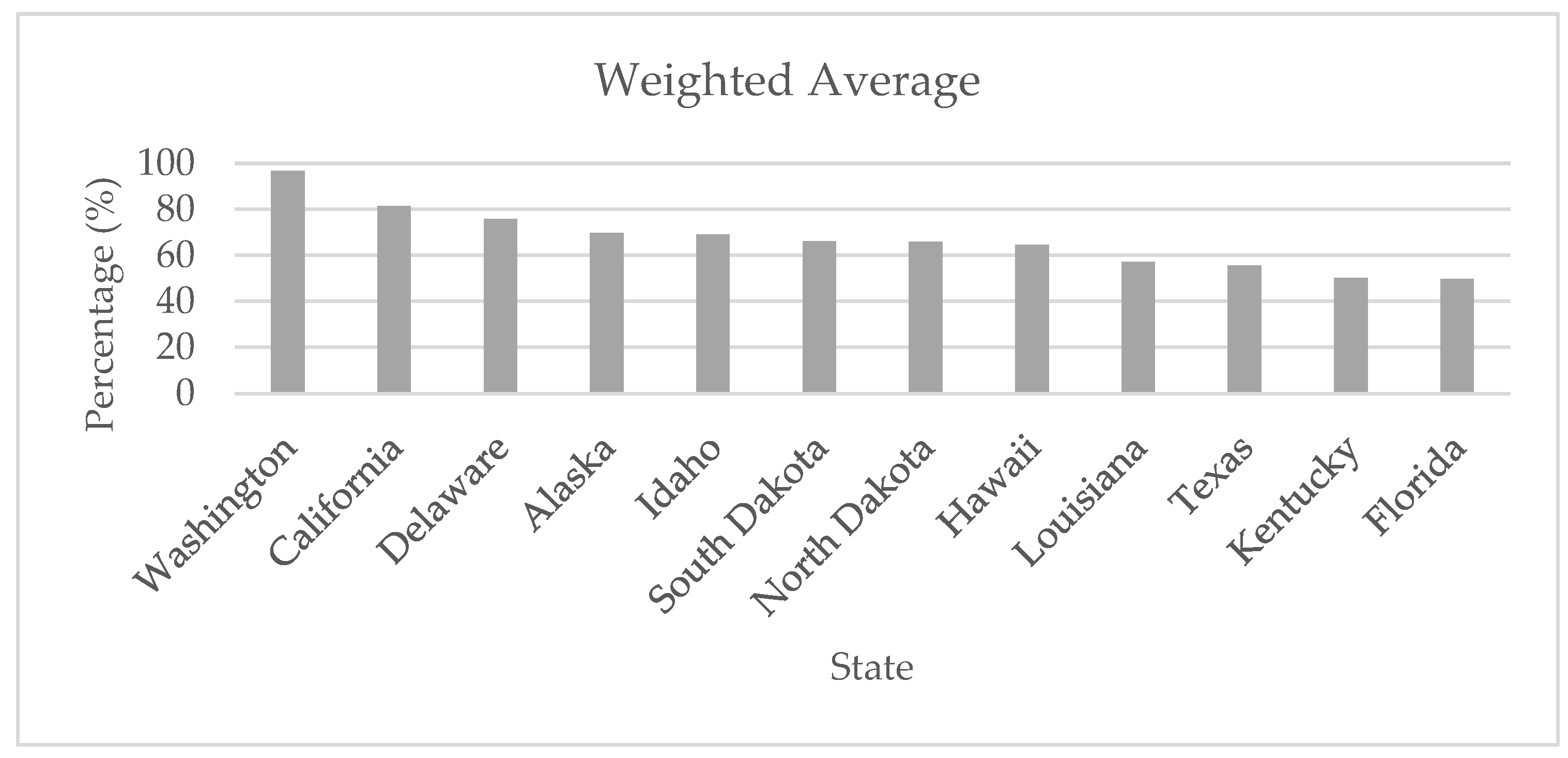
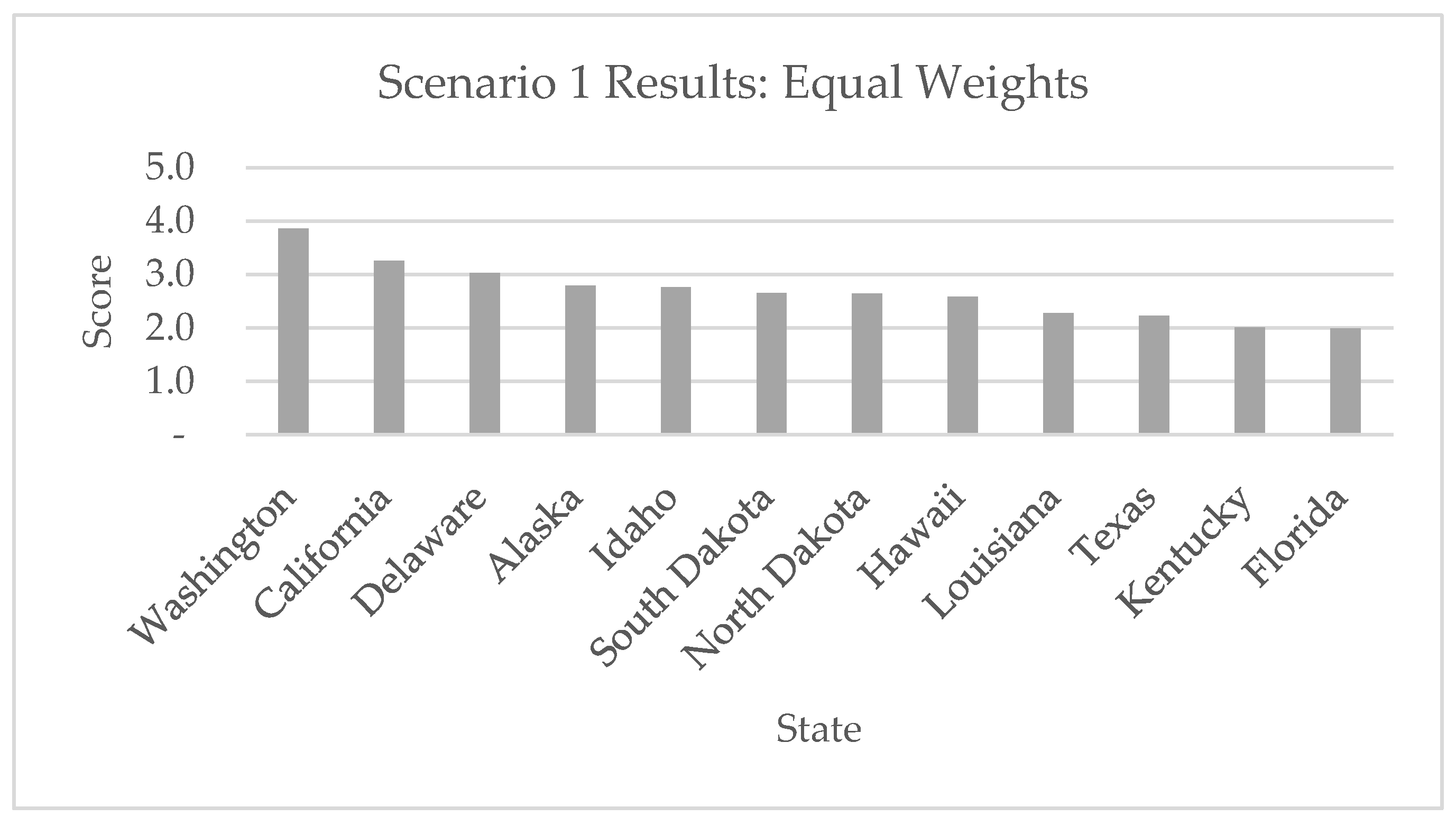

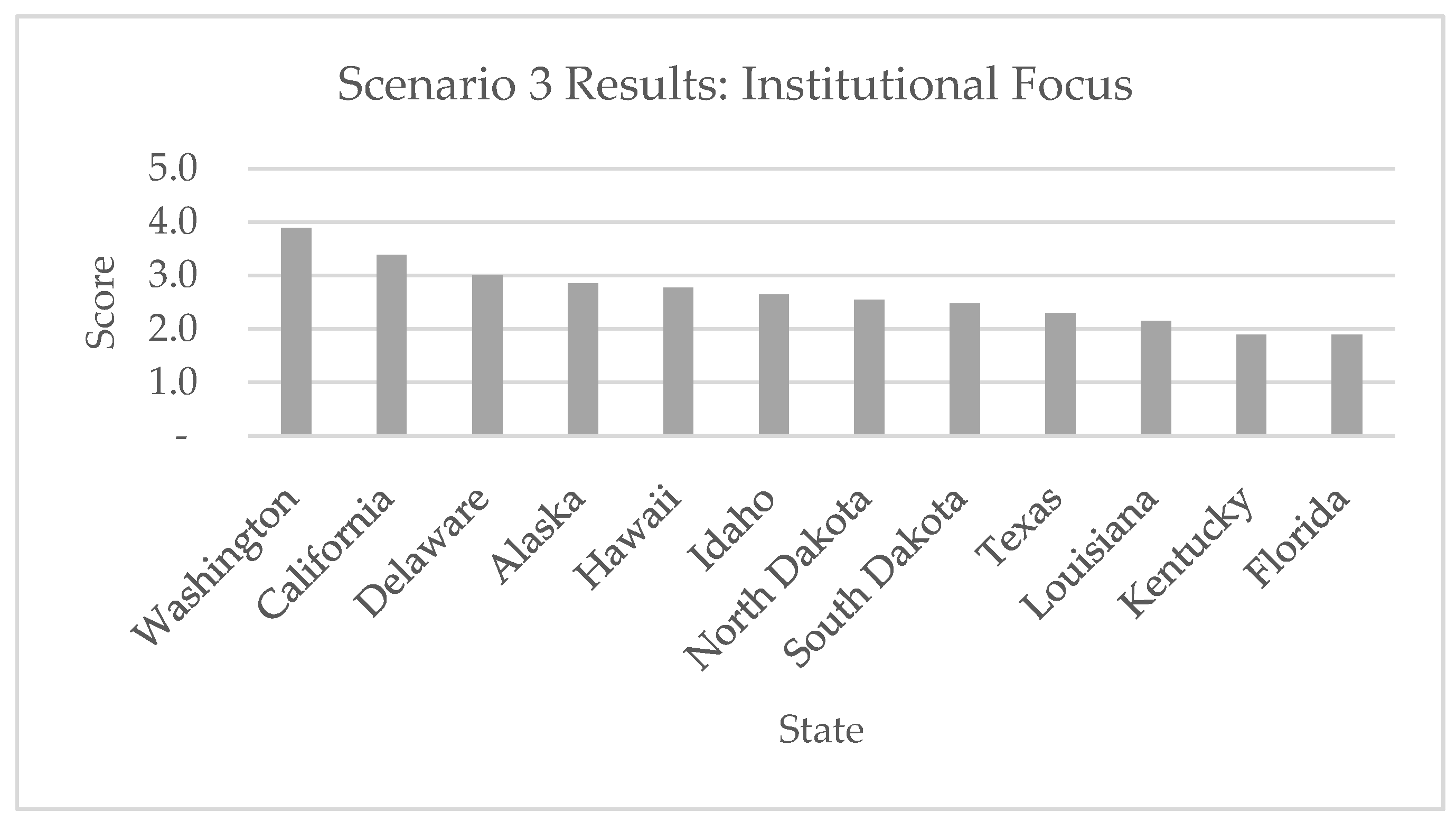
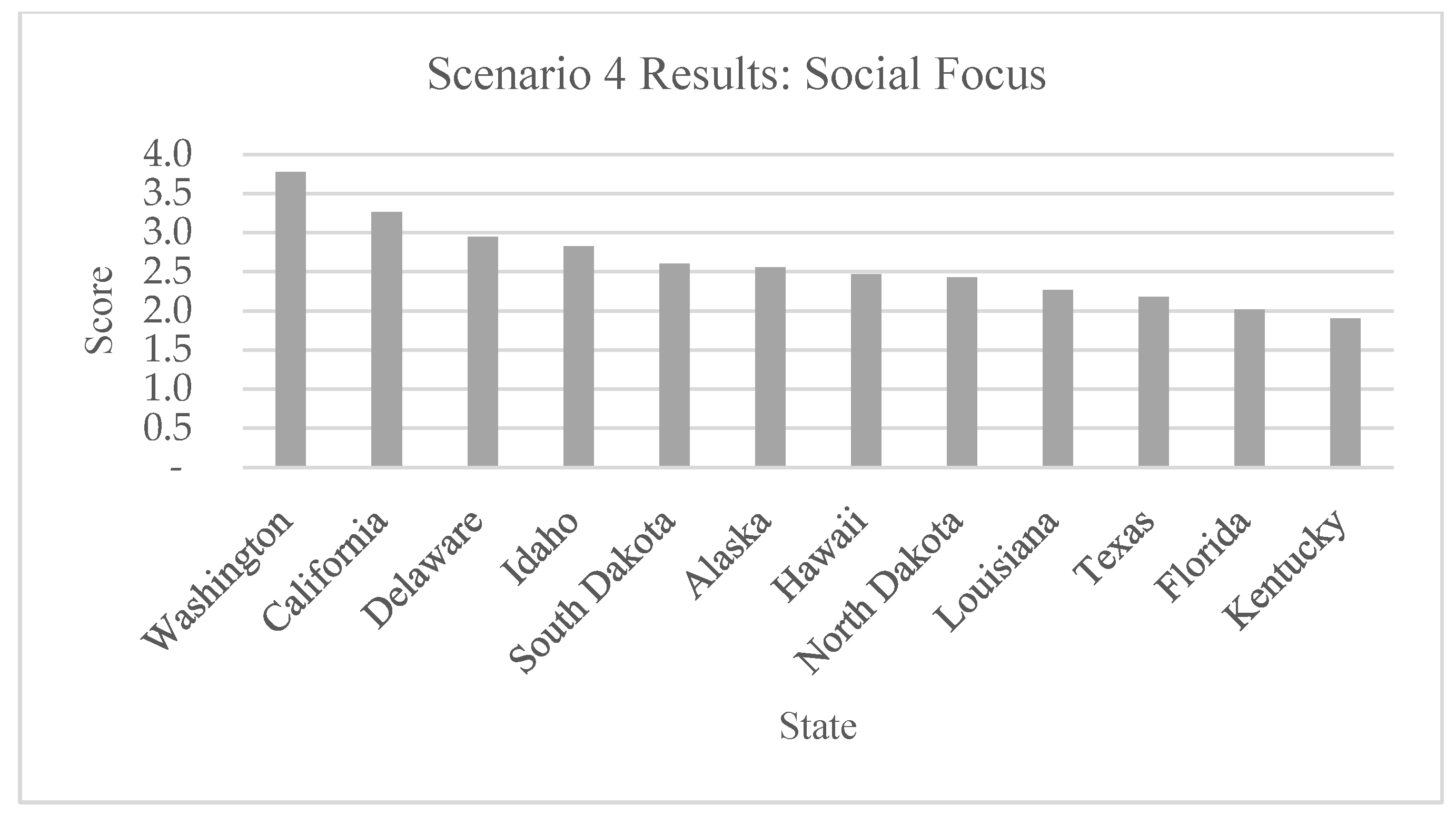

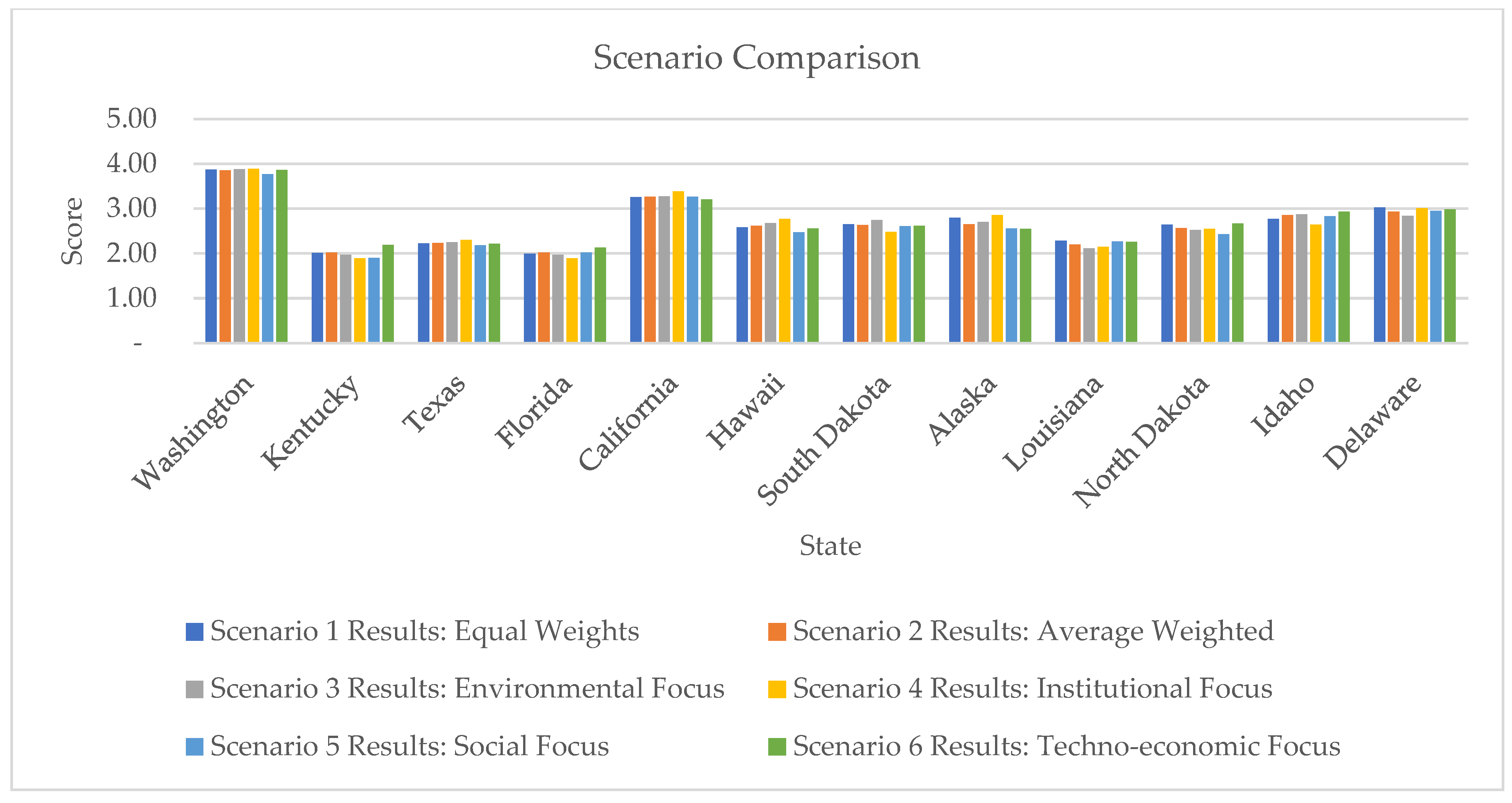
| State | Solar Capacity (MW) | Wind Capacity (MW) | Hydro- Electric Generation (MWh) | Renewable Share (%) | Average Retail Price of Electricity (Cents/kWh) | Average per Capita Use (MWh/Person/Year) | RPS | EERS | Net Metering |
|---|---|---|---|---|---|---|---|---|---|
| Alaska | 15 | 64 | 1,764,000 | 30.78 | 19.82 | 12.39 | No | No | Yes |
| California | 34,950 | 5922 | 21,377,000 | 42.59 | 18 | 15.80 | Yes | Yes | Yes |
| Delaware | 163 | 2 | 0 | 2.52 | 10.24 | 8.90 | Yes | Yes | Yes |
| Florida | 8206 | 0 | 232,000 | 4.29 | 10.06 | 8.88 | No | No | Yes |
| Hawaii | 1468 | 233 | 99,000 | 15.87 | 27.55 | 16.54 | Yes | Yes | No |
| Idaho | 613 | 973 | 9,508,000 | 76.08 | 7.99 | 7.52 | Yes | No | No |
| Kentucky | 71 | 0 | 5,005,000 | 8.49 | 8.58 | 6.28 | No | No | No |
| Louisiana | 203 | 0 | 1,204,000 | 3.33 | 7.51 | 5.23 | No | No | No |
| North Dakota | 2 | 3989 | 2,450,000 | 38.14 | 8.53 | 3.57 | Yes | No | Yes |
| South Dakota | 2 | 2305 | 5,831,000 | 80.51 | 10.06 | 6.98 | Yes | Yes | No |
| Texas | 13,845 | 33,133 | 1,079,000 | 21.84 | 8.36 | 6.83 | Yes | Yes | No |
| Washington | 298 | 3395 | 76,410,000 | 75.02 | 8.33 | 8.89 | Yes | Yes | Yes |
| State | Environmental | Institutional | Social | Techno-Economic |
|---|---|---|---|---|
| Washington | 4.00 | 4.00 | 3.67 | 3.80 |
| Kentucky | 1.67 | 1.50 | 1.67 | 3.20 |
| Texas | 2.33 | 2.50 | 1.67 | 2.40 |
| Florida | 1.67 | 1.50 | 2.00 | 2.80 |
| California | 3.33 | 3.75 | 3.33 | 2.60 |
| Hawaii | 3.00 | 3.25 | 2.33 | 2.00 |
| South Dakota | 3.33 | 2.00 | 2.33 | 2.60 |
| Alaska | 3.00 | 3.50 | 2.67 | 2.00 |
| Louisiana | 1.67 | 2.00 | 2.67 | 2.80 |
| North Dakota | 2.33 | 2.50 | 2.33 | 3.40 |
| Idaho | 3.00 | 2.00 | 2.67 | 3.40 |
| Delaware | 2.33 | 3.25 | 3.33 | 3.20 |
| Average | 2.64 | 2.65 | 2.56 | 2.85 |
| Source | Environmental | Institutional | Social | Techno-Economic |
|---|---|---|---|---|
| Florida | 0.35 | 0.20 | 0.17 | 0.28 |
| Delaware | 0.40 | 0.20 | 0.10 | 0.30 |
| Alaska | 0.23 | 0.17 | 0.30 | 0.30 |
| Kentucky | 0.20 | 0.20 | 0.27 | 0.33 |
| EIA | 0.25 | 0.25 | 0.25 | 0.25 |
| Averaged-Study Scenario | 0.29 | 0.20 | 0.22 | 0.29 |
| Original Study-Poland | 0.30 | 0.23 | 0.10 | 0.37 |
| State Performance | Environmental (%) | Institutional (%) | Social (%) | Techno-Economic (%) | Composite (%) |
| Washington | 100.0 | 100.0 | 91.7 | 95.0 | 96.7 |
| California | 83.3 | 93.8 | 83.3 | 65.0 | 81.4 |
| Alaska | 75.0 | 87.5 | 66.7 | 50.0 | 69.8 |
| Delaware | 58.3 | 81.3 | 83.3 | 80.0 | 75.7 |
| Hawaii | 75.0 | 75.0 | 58.3 | 50.0 | 64.6 |
| North Dakota | 58.3 | 62.5 | 58.3 | 85.0 | 66.0 |
| Texas | 58.3 | 62.5 | 41.7 | 60.0 | 55.6 |
| Idaho | 75.0 | 50.0 | 66.7 | 85.0 | 69.2 |
| Louisiana | 41.7 | 50.0 | 66.7 | 70.0 | 57.1 |
| South Dakota | 83.3 | 50.0 | 66.7 | 65.0 | 66.3 |
| Florida | 41.7 | 37.5 | 50.0 | 70.0 | 49.8 |
| Kentucky | 41.7 | 37.5 | 41.7 | 80.0 | 50.2 |
| Variable | Coefficient | p Value |
|---|---|---|
| Policy Driver | 0.2338 * | 0.0119 |
| Technology Driver | 0.3687 ** | 0.0036 |
| Stakeholder Participation | −0.0536 | 0.8339 |
| Policy–Technology Interaction | −0.0318 ** | 0.0082 |
| Adjusted R2 | 0.84 |
Disclaimer/Publisher’s Note: The statements, opinions and data contained in all publications are solely those of the individual author(s) and contributor(s) and not of MDPI and/or the editor(s). MDPI and/or the editor(s) disclaim responsibility for any injury to people or property resulting from any ideas, methods, instructions or products referred to in the content. |
© 2025 by the authors. Licensee MDPI, Basel, Switzerland. This article is an open access article distributed under the terms and conditions of the Creative Commons Attribution (CC BY) license (https://creativecommons.org/licenses/by/4.0/).
Share and Cite
Fache, A.; Bhat, M.G.; Troxler, T.G. Renewable Energy Policies in the USA: A Comparative Study of Selected States. Energies 2025, 18, 607. https://doi.org/10.3390/en18030607
Fache A, Bhat MG, Troxler TG. Renewable Energy Policies in the USA: A Comparative Study of Selected States. Energies. 2025; 18(3):607. https://doi.org/10.3390/en18030607
Chicago/Turabian StyleFache, Anna, Mahadev G. Bhat, and Tiffany G. Troxler. 2025. "Renewable Energy Policies in the USA: A Comparative Study of Selected States" Energies 18, no. 3: 607. https://doi.org/10.3390/en18030607
APA StyleFache, A., Bhat, M. G., & Troxler, T. G. (2025). Renewable Energy Policies in the USA: A Comparative Study of Selected States. Energies, 18(3), 607. https://doi.org/10.3390/en18030607







